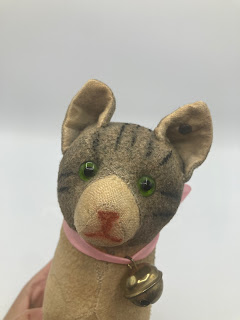Let's now take a look at how she is cataloged in Pfeiffer's 1892-1943 Sortiment. It says, "Rauhstoff, Grau/weiss, sitzend, billige Series." This translates to English as "Rough cloth, grey/white, sitting, cheap series." These descriptors are very telling about her construction and era of production in two key ways.
First, let's consider her material. It is called rough cloth or coat plush. This is the first time that Steiffgal had handled an item made from this wartime era fabric, it is that unusual. More commonly noted substitute fabrics found on items produced just before and just after WWII include wool plush, artificial silk plush, cotton plush, and linen. From an aesthetic perspective, this material looks and feels a bit like flannel cloth - the fabric usually seen on nightclothes and plaid shirts! It has a very slightly fuzzy surface. Steiffgal suspects that the absence of this fabric appearing over a wide range Steiff prewar designs suggests that it was unpopular, hard to work with, and/or unavailable on a commercial level.
However, it is interesting to note that coat plush was used on two other cat models around the same time as this one. One, a standing version, was made in 14, 17, and 22 cm from 1931-1933. This same model was also produced on blue eccentric wooden wheels as a pull toy in 14, 17, and 22 cm from 1931-1932.
And second, let's noodle what Pfeiffer might mean by the words "cheap series." It is unclear if this specifically means "cheap to manufacture" or "cheap (or cheaper) to purchase", or both. The early 1930s at Steiff were a time when the company was implementing numerous strategies to slash costs and create efficiencies throughout the entire organization. So the chronology of these words does make sense. This sitting cat was made at the same time as a number of the company's now legacy sitting cats, including Susi, the sweet tabby; Siamy, the Siamese cat; and Fluffy, the adorable blue tipped kitten. Clearly, these head jointed mohair cats were far more elegant in their materials, construction, and detailing than this basic, unjointed one. This "cheap series" cat also has simple painted facial features - not embroidered ones - which are far more economical to apply than hand embroidered ones.
All of these small tweaks in the aggregate certainly brought her costs down... but not her appeal or importance in the company's product development timeline in any way.
Steiffgal hopes this discussion on this prewar era coat plush rarity has warmed your heart and soul!
Have a question about one of your Steiff treasures? Let's talk! Click here to learn more.




















